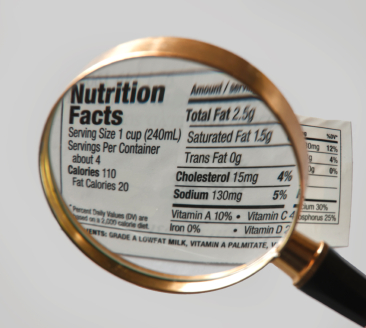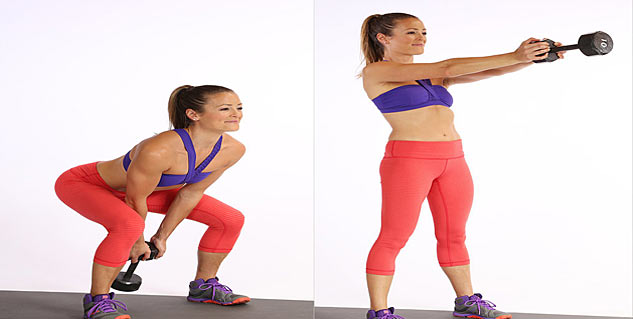Healthy Living 101: How to Read a Nutrition Label
Too often, purchasing food can be confusing, especially with all of the persuasive marketing tactics used by food companies. Learning how to read, understand, and compare food labels can help you maintain, manage, control, and/or reduce health issues such as weight, diabetes, high cholesterol, and high blood pressure. Use this guide to help you make more informed choices:

The serving size is the most important part of the label. It will tell you what amount of the food will provide the nutrition found below it. If you eat more or less than the serving size, you will need to adjust the rest of the label accordingly. For example, a can of soup may have a serving size of one cup with a total of two servings (two cups). If you eat all of the soup, you will have to double everything on the label.
You will notice that many of the items listed on the nutrition label will have a percent next to them. It is important to understand that this is based on a 2,000-calorie-per-day diet. Since every body is different, it is not appropriate for everyone to eat 2,000 calories every day. Your daily values may be higher or lower depending on various factors, including your gender, height, weight, age, and activity.
3. CaloriesCalories are the amount of energy supplied by a food.
4. Calories from FatLess than 30% of your total calories should come from fat.
5. Total FatThis is the total amount of fat found in the serving size. The total is broken down by the type of fat (saturated, trans, polyunsaturated, and monounsaturated) found directly underneath this.
- Saturated fat - Limit saturated fat to 10% of total daily calories. According to the Centers for Disease Control and Prevention, "Diets high in saturated fat have been linked to chronic disease, specifically, coronary heart disease."
- Trans fat - Try to avoid trans fats at all costs. Trans fats can increase your "bad" cholesterol and reduce your "good" cholesterol. Food companies can list a food as "trans fat free" if it has 0.5 g or less per serving. In addition to looking on the label, also look at the list of ingredients. If it has "hydrogenated" oil in it, it contains trans fats.
- Monounsaturated and Polyunsaturated fats - The majority of your fat intake should come from these sources. Examples of good sources include: nuts, canola oil, olive oil, and avocado.

6. Cholesterol
Most people should limit their cholesterol to 300 mg a day or less. For people with high cholesterol, this number is reduced to 150 mg or less a day.
7. SodiumThe American Heart Association recommends limiting sodium intake to 1500 mg a day.
8. Total CarbohydrateSimilar to the total fat listed on the label, the breakdown of the total amount of carbohydrates is found directly below it (fiber and sugar).
- Fiber - A food that has 5 g of fiber or more is a good source of fiber - aim to eat 25-35 g of fiber a day.
- Sugar - The sugar listed can be both added and/or naturally occurring.
This is the amount of protein found in one serving.
10. Vitamins and MineralsFood companies are required to list vitamin A and C content, but may voluntarily list others.
11. FootnoteUnder the vitamins and minerals is a footnote that gives recommended levels of intakes based on 2,000 and 2,500 calorie diets. If your calorie intake falls within this range, this may be a helpful tool.
Mandy Seay is a bilingual registered and licensed dietitian who holds both a bachelor's degree in nutrition and in journalism. After gaining 30 pounds while living abroad, Mandy worked to lose the weight and regain her health. It was here that she discovered her passion for nutrition and went on to pursue a career as a dietitian. Mandy currently works as a nutrition consultant and freelance writer in Austin, Texas, where she specializes in diabetes, weight management and general and preventive nutrition. She recently published her first book, Your Best Health, a personalized program to losing weight and gaining a healthy lifestyle.If you would be interested in working with Mandy one-on-one, sign-up for FitDay Dietitian.
-
How An Arizona Nun Fights Obesity Among Pima Indian Children
The Pima Indians in the United States have the highest prevalence of t
-
Fasting For Weight Loss - Why is it So Effective?
Fasting for weight loss is most definitely a hot topic. With everyb
-
Hamptons Diet What Are The Benefits And Pitfalls Of The Hamptons Diet
What is the Hamptons Diet and what are its benefits and its shortcomin
-
Hypnosis Weight Loss! Does It Really Work?
Controlling your weight and avoiding weight gain as you get older a
-
500-calorie Per Day Diet Warning!
Supposing you have tried many other diets and have been disappointed b
-
Using Cinnamon To Lose Body Fat Faster
Putting some cinnamon in your coffee ins
- DON'T MISS
- Are Weight Loss Supplements Effective In Weight Loss ?
- Easy Ideas To Banish Those Unwanted Pounds
- The Easily Ignored Dangers Experienced with Some Weight reduction Products
- 4 Unlikely Techniques To Help You Lose Weight
- Top 10 Self Cleanses
- Stay Healthy, Live Longer : Follow Good Diet Chart
- Lose Ten Pounds -- Permanently
- How to Lose Your Tummy and Keep Your Outlook Sunny
- How Slowing Down Your Eating Speed Can Help You Lose Weight
- Diets For Extreme Weight Loss




